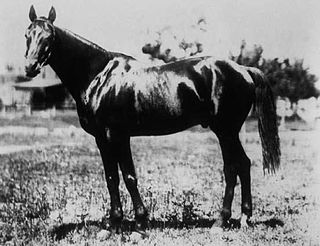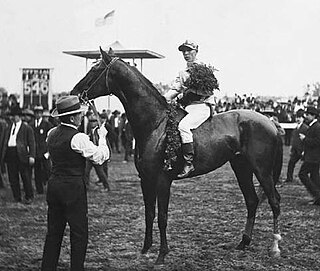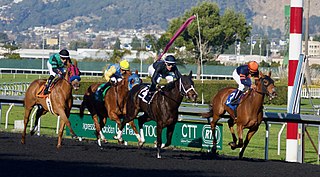Xcellent is a thoroughbred racehorse who was trained by Michael & Paul Moroney.

Sir Percy is a British Thoroughbred race horse and sire. In a career which lasted from July 2005 to June 2007 he ran ten times and won five races. he was among the leading British two-year-olds of 2005, when his win included the Dewhurst Stakes. In the following year he recorded his most important success when winning The Derby. He was retired to stud after three unsuccessful starts in 2007.

Dark Ronald was an English bred Thoroughbred racehorse and sire with a global influence on the breeding of Thoroughbreds and sport horses, with many show jumpers tracing back to him.

Gallant Man was a thoroughbred racehorse, named for a horse in a Don Ameche movie. He was one of the most successful racehorses foaled outside the United States with his near miss in the 1957 Kentucky Derby and his record 1957 Belmont Stakes win. His exact foaling date was unknown or at best debated over the years of his life and many years after. The supporting evidence from a review of foaling stall records in Ireland indicates that he was born on the Saturday after St. Patrick's Day during a highly productive foaling weekend for many thoroughbred mothers on the same farm. His dam, Majideh, is recorded as being in the foaling stall without a live foal until March 20, 1954 at approximately 7:45 AM.
Somethingroyal was an American Thoroughbred racehorse best known as the dam of U.S. Triple Crown champion and Hall of Fame inductee Secretariat. She also produced three other stakes winners and was named the 1973 Kentucky Broodmare of the Year.

Sir Archy was an American Thoroughbred racehorse considered one of the best racehorses of his time and later an important sire.
Uttermost was a Canadian Thoroughbred racehorse who in 1945 won the three races that later formed the official Canadian Triple Crown series.
Purchase, an American Thoroughbred racehorse, was called "The Adonis of the Turf." Walter Vosburgh, the official handicapper for The Jockey Club as well as a turf historian for many years, wrote: "…one of the most exquisitely beautiful of racehorses…to describe Purchase would be to exhaust the superlative."
Sir Slick is a bay gelding Thoroughbred racehorse by Volksraad from the Paris Opera mare Miss Opera. The New Zealand bred Sir Sick raced nationally and internationally performing in New Zealand, Australia, Singapore and Hong Kong. He is the winner of Six Group One races in New Zealand, Also known as The War Horse / Iron Horse, He became one of the country's most popular Racehorses of his time due to his success's and his ability to withstand long racing campaigns. He was bred by Monovale Holdings Ltd,.

Chant was an American Thoroughbred racehorse that won the 1894 Kentucky Derby, Phoenix Stakes, and Clark Handicap. He was related through his damsire, King Alfonso, to Kentucky Derby winners Fonso (1880) and Joe Cotton (1885) and through his sire, Falsetto, to His Eminence (1901) and Sir Huon (1906).

Sir Huon was an American Thoroughbred racehorse that was the winner of the 1906 Kentucky Derby and Latonia Derby. Sir Huon was named after a character in the German opera Oberon and was bred at George J. Long's stud farm, Bashford Manor Stable. He was sired by the great turf-racer Falsetto, who was greatly aged by then at near thirty years old, out of the mare Ignite.

Eleanor was a British Thoroughbred racehorse bred by Charles Bunbury and was the first female horse to win The Derby. Eleanor also won the 1801 Epsom Oaks among many other races before retiring from racing at age eight to become a broodmare for Bunbury. She produced the stallion Muley, which in turn sired the mare Marpessa and the influential stallion Leviathan which was exported to the United States in the early nineteenth century. Through the produce of her daughter Active, Eleanor is present in the pedigrees of 19th-century American Standardbred racehorses.

Waxy was a British Thoroughbred racehorse that won the 1793 Epsom Derby and was an influential sire in the late eighteenth and early part of the nineteenth century. Waxy was bred by Sir Ferdinando Poole and was foaled at Lewes in 1790. He was sired by Pot-8-Os, a son of the foundation stallion Eclipse, whose genetic lineage traced to the Darley Arabian. Waxy's dam, Maria, was sired by the influential stallion Herod and produced one full-brother to Waxy, who was named Worthy. Waxy derived his name from a variety of potato, a choice that was inspired by his sire's name. Trained by Robert Robson, Waxy won nine races out of 15 starts during his four-year racing career, retiring from racing at the age of seven in 1797 after sustaining an injury during his last start.
Tyrant was a British Thoroughbred racehorse and sire. In a career that lasted from April 1802 to April 1803 he ran four times and won two races. In the summer of 1802 he won the Derby on his second racecourse appearance, but the rest of his form was moderate and he was not considered the best of his generation.
L'Abbesse de Jouarre was a Thoroughbred racehorse that won the 1889 Epsom Oaks. The horse was owned by Lord Randolph Churchill and the Earl of Dunraven during her three-year racing career. She was nicknamed "Abscess on the Jaw" during her career due to the difficulty the public had pronouncing her name. A versatile racehorse, she was able to win major races at distances ranging from six furlongs to one and a half miles. Retired from racing in 1891, L'Abbesse was the dam of the influential German broodmare Festa and the leading stallion Desmond. L'Abbesse de Jouarre died 6 March 1897 during foaling.

Symmetry was a British Thoroughbred racehorse and sire best known for winning the classic St Leger Stakes in 1798. Originally trained in Yorkshire won the St Leger at Donacaster on his final appearance as a three-year-old and when on to defeat The Derby winner Sir Harry in a match race at York in the following year. As a five-year-old he was transferred to race at Newmarket where he lost a rematch with Sir Harry, but won his three remaining races, including matches against Sorcerer and Diamond, two of the leading racehorses of the time. After his retirement from racing, Symmetry was sold and exported to stand as a breeding stallion in Russia.
Tartar was a British Thoroughbred racehorse best known for winning the classic St Leger Stakes in 1792. One of the smallest horses to win a classic, he won the St Leger on his racecourse debut in September 1792. He won twice in the following season before racing without success in 1794.
Waterloo was British Thoroughbred racehorse and broodmare best known for winning the classic 1000 Guineas in 1972. Waterloo was one of the leading British two-year-olds of 1971 when her wins included the Queen Mary Stakes and the Cheveley Park Stakes. In the following year she followed up her victory in the Guineas by winning the Falmouth Stakes. She was later sold and exported to the United States and had some success as a broodmare.

The 1987 King George VI and Queen Elizabeth Stakes was a horse race held at Ascot Racecourse on Saturday 25 July 1987. It was the 37th running of the King George VI and Queen Elizabeth Stakes.












